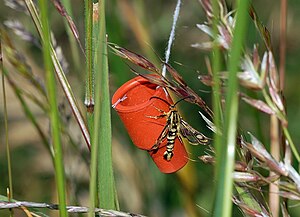Cypress wolfmilk glass winged wing
| Cypress wolfmilk glass winged wing | ||||||||||||
|---|---|---|---|---|---|---|---|---|---|---|---|---|

Cypress wolffish glass-winged winged wing |
||||||||||||
| Systematics | ||||||||||||
|
||||||||||||
| Scientific name | ||||||||||||
| Chamaesphecia empiformis | ||||||||||||
| ( Esper , 1783) |
The cypress wolf milk glass winged ( Chamaesphecia empiformis ) is a butterfly from the family of the glass winged wing (Sesiidae).
features
The moths reach a wingspan of 13 to 22 millimeters. They have transparent wings, the wing veins and edges of which are pale yellow and darkly scaled. A wide, black transverse band can be seen on the forewings. The abdomen is pale yellow and partly with dark scales, with rings visible. At the end of the abdomen there is a broad, dark fan and at the front edge and in the middle yellow fan.
The caterpillars are about 20 millimeters long. They are whitish in color and have a brown head. The neck shield is only very weakly hardened.
Occurrence
The animals live in open and dry areas, such as B. on dry grass , in gravel pits or at the edges of forests where their forage plants grow.
Way of life
The diurnal moths are difficult to recognize because of their small size, but they can be found when sucking nectar on cypress spurge ( Euphorbia cyparissias ), privet ( Ligustrum spec. ) And water duster ( Eupatorium spec. ).
Flight and caterpillar times
The moths fly from late May to late August, the caterpillars are found from September to May of the following year.
Food of the caterpillars
The caterpillars feed monophag on cypress spurge ( Euphorbia cyparissias ), in whose woody rootstocks they live.
development
The females lay their oval, black eggs one by one on the leaves of their food plant. The caterpillars that hatch from it eat a six to seven centimeter long passage in the rootstock of the plants. In autumn the plants dry up much earlier than those that are not infected. Pupation takes place in the rhizome.
swell
Individual evidence
- ↑ a b c d e f Heiko Bellmann : The new Kosmos butterfly guide. Butterflies, caterpillars and forage plants. Franckh-Kosmos, Stuttgart 2003, ISBN 3-440-09330-1 , p. 60.
- ↑ Chamaesphecia empiformis. Butterflies-Deutschlands.de, Christian Tolasch, accessed on November 8, 2006 .
- ↑ Manfred Koch , Wolfgang Heinicke: We determine butterflies. 3. Edition. Neumann, Radebeul 1991, ISBN 3-7402-0092-8 .
Web links
- www.lepiforum.de Taxonomy and photos
- Moths and Butterflies of Europe and North Africa (English)
- Chamaesphecia empiformis in Fauna Europaea
